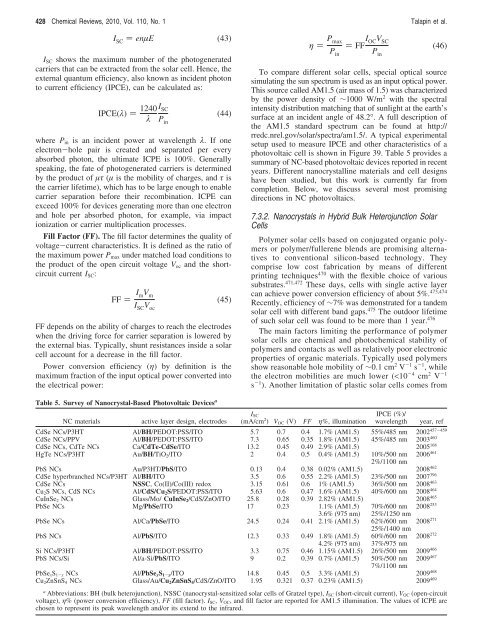Prospects of Colloidal Nanocrystals for Electronic - Computer Science
Prospects of Colloidal Nanocrystals for Electronic - Computer Science
Prospects of Colloidal Nanocrystals for Electronic - Computer Science
You also want an ePaper? Increase the reach of your titles
YUMPU automatically turns print PDFs into web optimized ePapers that Google loves.
428 Chemical Reviews, 2010, Vol. 110, No. 1 Talapin et al.<br />
I SC ) enµE (43)<br />
ISC shows the maximum number <strong>of</strong> the photogenerated<br />
carriers that can be extracted from the solar cell. Hence, the<br />
external quantum efficiency, also known as incident photon<br />
to current efficiency (IPCE), can be calculated as:<br />
IPCE(λ) ) 1240 ISC λ Pin where Pin is an incident power at wavelength λ. Ifone<br />
electron-hole pair is created and separated per every<br />
absorbed photon, the ultimate ICPE is 100%. Generally<br />
speaking, the fate <strong>of</strong> photogenerated carriers is determined<br />
by the product <strong>of</strong> µτ (µ is the mobility <strong>of</strong> charges, and τ is<br />
the carrier lifetime), which has to be large enough to enable<br />
carrier separation be<strong>for</strong>e their recombination. ICPE can<br />
exceed 100% <strong>for</strong> devices generating more than one electron<br />
and hole per absorbed photon, <strong>for</strong> example, via impact<br />
ionization or carrier multiplication processes.<br />
Fill Factor (FF). The fill factor determines the quality <strong>of</strong><br />
voltage-current characteristics. It is defined as the ratio <strong>of</strong><br />
the maximum power Pmax under matched load conditions to<br />
the product <strong>of</strong> the open circuit voltage Voc and the shortcircuit<br />
current ISC:<br />
FF ) I m V m<br />
I SC V oc<br />
FF depends on the ability <strong>of</strong> charges to reach the electrodes<br />
when the driving <strong>for</strong>ce <strong>for</strong> carrier separation is lowered by<br />
the external bias. Typically, shunt resistances inside a solar<br />
cell account <strong>for</strong> a decrease in the fill factor.<br />
Power conversion efficiency (η) by definition is the<br />
maximum fraction <strong>of</strong> the input optical power converted into<br />
the electrical power:<br />
Table 5. Survey <strong>of</strong> Nanocrystal-Based Photovoltaic Devices a<br />
(44)<br />
(45)<br />
NC materials active layer design, electrodes<br />
η ) P max<br />
P in<br />
) FF I OC V SC<br />
P in<br />
To compare different solar cells, special optical source<br />
simulating the sun spectrum is used as an input optical power.<br />
This source called AM1.5 (air mass <strong>of</strong> 1.5) was characterized<br />
by the power density <strong>of</strong> ∼1000 W/m 2 with the spectral<br />
intensity distribution matching that <strong>of</strong> sunlight at the earth’s<br />
surface at an incident angle <strong>of</strong> 48.2°. A full description <strong>of</strong><br />
the AM1.5 standard spectrum can be found at http://<br />
rredc.nrel.gov/solar/spectra/am1.5/. A typical experimental<br />
setup used to measure IPCE and other characteristics <strong>of</strong> a<br />
photovoltaic cell is shown in Figure 39. Table 5 provides a<br />
summary <strong>of</strong> NC-based photovoltaic devices reported in recent<br />
years. Different nanocrystalline materials and cell designs<br />
have been studied, but this work is currently far from<br />
completion. Below, we discuss several most promising<br />
directions in NC photovoltaics.<br />
7.3.2. <strong>Nanocrystals</strong> in Hybrid Bulk Heterojunction Solar<br />
Cells<br />
Polymer solar cells based on conjugated organic polymers<br />
or polymer/fullerene blends are promising alternatives<br />
to conventional silicon-based technology. They<br />
comprise low cost fabrication by means <strong>of</strong> different<br />
printing techniques 470 with the flexible choice <strong>of</strong> various<br />
substrates. 471,472 These days, cells with single active layer<br />
can achieve power conversion efficiency <strong>of</strong> about 5%. 473,474<br />
Recently, efficiency <strong>of</strong> ∼7% was demonstrated <strong>for</strong> a tandem<br />
solar cell with different band gaps. 475 The outdoor lifetime<br />
<strong>of</strong> such solar cell was found to be more than 1 year. 476<br />
The main factors limiting the per<strong>for</strong>mance <strong>of</strong> polymer<br />
solar cells are chemical and photochemical stability <strong>of</strong><br />
polymers and contacts as well as relatively poor electronic<br />
properties <strong>of</strong> organic materials. Typically used polymers<br />
show reasonable hole mobility <strong>of</strong> ∼0.1 cm 2 V -1 s -1 , while<br />
the electron mobilities are much lower (
















